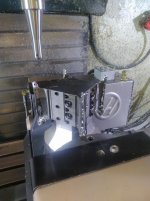Pete Deal
Titanium
- Joined
- Apr 10, 2007
- Location
- Morgantown, WV
I make a lot of low value small parts out of 6061 and 1018. To try to make it worth the effort I machine them in strips. All of these parts need to be machined on at least 3 sides and many of them 5 sides. Currently I have a few Orange double vises setup and each set of jaws is an operation.
I have 4th axis for both of my machines but currently don't use them. I've been thinking for a long time how it would be a great improvement in efficiency and accuracy if I could hit 3 sides of the parts in one operation using my 4th axis. There are all kinds of interesting holding gadgets around but I've never seen anything to hold parts this way. What I would really like to do is to have some sort of compact talon grip type setup to hold the bar but that would take a super short compact but wide vise.
My latest idea is to make some sort of square tomb stone say like 4" square then make little pallets that could be bolted onto the faces. I would need to get an end support (tailstock) to go with the 4th.
Anybody got any very clever ideas for holding parts this way?
I have 4th axis for both of my machines but currently don't use them. I've been thinking for a long time how it would be a great improvement in efficiency and accuracy if I could hit 3 sides of the parts in one operation using my 4th axis. There are all kinds of interesting holding gadgets around but I've never seen anything to hold parts this way. What I would really like to do is to have some sort of compact talon grip type setup to hold the bar but that would take a super short compact but wide vise.
My latest idea is to make some sort of square tomb stone say like 4" square then make little pallets that could be bolted onto the faces. I would need to get an end support (tailstock) to go with the 4th.
Anybody got any very clever ideas for holding parts this way?





